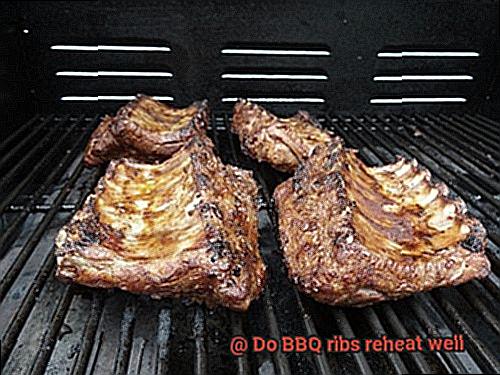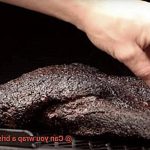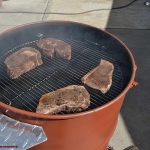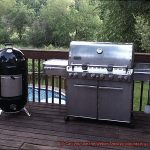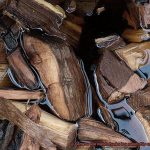Picture this: sinking your teeth into tender, smoky, and lip-smacking BBQ ribs, drenched in a sauce that makes you want to lick your fingers clean. The sheer delight of devouring such an indulgent dish is beyond compare. But what if you find yourself with some leftovers, yearning to relive that irresistible taste? Here’s the burning question: Do BBQ ribs reheat well?
Fear not, my friends. Today, we’re going to uncover the secrets to reheating BBQ ribs flawlessly, ensuring each bite is as heavenly and satisfying as the very first. We’ll explore foolproof techniques and insider tips, guaranteeing that your leftover ribs retain their juicy tenderness and that mouthwatering smokiness.
So, whether you’re a grilling maestro cooking up a storm or simply a BBQ aficionado craving a second-day delight, fasten your seatbelts and get ready to dive headfirst into the world of reheating BBQ ribs like never before.
Contents
What Are BBQ Ribs?
BBQ ribs are not just a simple dish; they are a culinary masterpiece that has captured the hearts and taste buds of people all over America. These succulent ribs, typically made from pork or beef, come in different cuts, each boasting its own unique flavor and texture. Whether it’s the tender and meaty baby back ribs, the juicy spare ribs, or the mouthwatering St. Louis-style ribs, there is a rib for every BBQ enthusiast.
The journey to achieve perfectly cooked BBQ ribs begins with seasoning. The meat is generously coated with a dry rub or marinade that is carefully crafted to elevate the flavors. A combination of aromatic spices like paprika, garlic powder, onion powder, brown sugar, salt, and pepper is used to create a magical harmony of taste. This dry rub not only enhances the natural flavors of the meat but also forms an irresistible crust that adds that extra layer of indulgence.
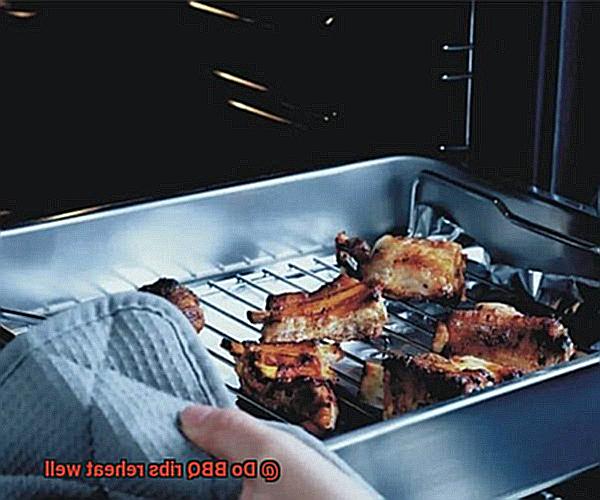
Once seasoned to perfection, the seasoned ribs embark on a slow cooking adventure. This is where patience truly becomes a virtue. The ribs are placed on a grill or smoker and cooked slowly over low heat. This slow cooking method allows the meat to become tender and juicy while also developing a smoky and charred exterior that will make your mouth water in anticipation.
But the journey doesn’t end there. To ensure maximum flavor and moisture, basting comes into play. Throughout the cooking process, the ribs are lovingly basted with a luscious BBQ sauce. This sauce can be sweet, tangy, spicy, or a tantalizing combination of flavors – it all depends on personal preference. This infusion of sauce adds an extra layer of succulence that will have you licking your fingers in delight.
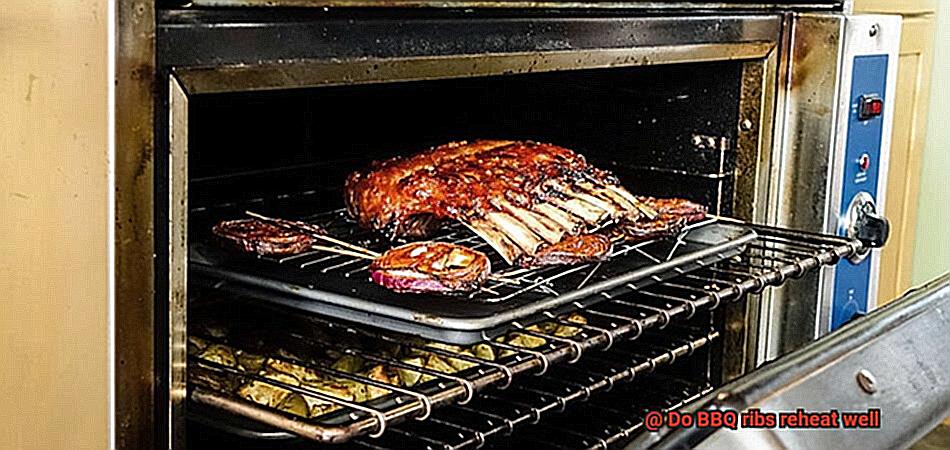
Finally, when the BBQ ribs have reached their peak of perfection, they are ready to be served. They emerge from their smoky cocoon, glazed with their mouthwatering sauce, beckoning you to take a bite. These tantalizing ribs are often accompanied by classic BBQ sides like coleslaw, baked beans, cornbread, or potato salad. The combination of flavors and textures creates a symphony of taste that will leave you craving more.
And what if you can’t finish all the deliciousness in one sitting? Fear not. BBQ ribs can be reheated to relive the magic. Whether you choose to use an oven or a grill, the key is to ensure thorough heating to eliminate any potential bacteria or foodborne illnesses. While reheating may not capture the same level of smokiness or crust as freshly cooked ribs, it can still bring back their tender and juicy qualities. Brushing them with some BBQ sauce or marinade before heating can enhance their flavor and moisture, ensuring every bite is as delectable as the first.
Reheating BBQ Ribs: Pros and Cons
Reheating BBQ ribs is a culinary tightrope walk, with its own set of pros and cons that can make or break your leftovers. Let’s sizzle through the key points:
Pros:
- Flavor Redemption: When done right, reheating BBQ ribs lets you savor the mouthwatering symphony of flavors all over again. The slow-cooking process during the initial grilling creates a complex blend of tastes that can be resurrected through reheating.
- Convenience Unleashed: Reheating BBQ ribs is a swift and convenient way to satiate your hunger pangs. It’s a godsend for time-strapped individuals or families who crave a scrumptious dinner without being shackled to the kitchen.
Cons:
- Deserted by Moisture: One false move while reheating and you risk turning those tender ribs into dry, chewy morsels. Slow-cooked ribs are dripping with succulence, but reheating them at high temperatures or for too long can transform them into Sahara-like deserts.
- Fading Smoke Symphony: BBQ ribs are renowned for their smoky allure, but reheating may dim that orchestral masterpiece. While some traces of smokiness may remain after reheating, it won’t sing as loudly as when those ribs were freshly kissed by the grill.
- Lost in Texture Translation: Microwaving or steaming may leave your reheated ribs without the crispy bark and charred edges craved by BBQ aficionados. These tantalizing textures are often the holy grail of any rib experience, and reheating methods may not be able to recreate them.
To achieve rib-heating nirvana, opt for lower heat methods like grilling over indirect flames, wrapping them in foil with a splash of liquid to retain moisture, or using the gentle embrace of a slow cooker. These strategies will help you preserve the tender juiciness, rich flavors, and tantalizing textures of the ribs.
Different Methods for Reheating BBQ Ribs
When it comes to reheating BBQ ribs, there are various methods to choose from, each with its own advantages and disadvantages. Let’s dive into the different methods and explore what makes each one unique.
- Oven method: This classic approach is favored by many for its ability to retain moisture, resulting in tender, juicy ribs. By wrapping the ribs tightly in aluminum foil and heating them in a preheated oven at a low temperature (around 250°F or 120°C) for about 20-30 minutes, you can achieve even heating throughout the meat. However, it’s important to note that this method may not achieve the same level of smoky flavor as grilling.
- Grill method: For those looking for that quintessential smoky flavor and a crispy exterior, the grill method is a go-to option. Preheat the grill to medium heat and brush the ribs with a thin layer of barbecue sauce to enhance flavor and moisture. Place the ribs on the grill and cook for about 5-10 minutes per side, basting with more sauce as needed. The result? Smoky goodness that will have your taste buds dancing. Just be careful not to dry out the meat by being mindful of cooking time and temperature.
- Microwave method: When time is of the essence, the microwave method can be a quick and convenient solution. However, it’s important to exercise caution as uneven heating can lead to loss of texture and potentially tough, dry ribs if overcooked. To minimize these risks, wrap the ribs in damp paper towels or place them in a microwave-safe dish with a lid to trap steam and prevent drying out. Heat them in short intervals, checking for doneness after each interval.
- Sous vide method: If precision is what you seek, look no further than the sous vide method. While it requires additional equipment (a sous vide cooker) and more time compared to other methods, it offers precise control over the temperature for evenly reheated, tender ribs. By vacuum-sealing the ribs and placing them in a water bath set at a specific temperature for an extended period of time, you can achieve restaurant-quality results in the comfort of your own kitchen.
- Repurposing leftovers: Don’t let those leftover rib meats go to waste. Repurposing them can offer a unique way to enjoy the flavors of BBQ ribs in a different form. Shred the meat and add it to tacos, sandwiches, or salads for an extra punch of flavor. This method allows you to get creative in the kitchen while making the most out of your leftovers. However, it’s worth noting that repurposing leftovers may not be suitable if you prefer the original rib texture and flavor.
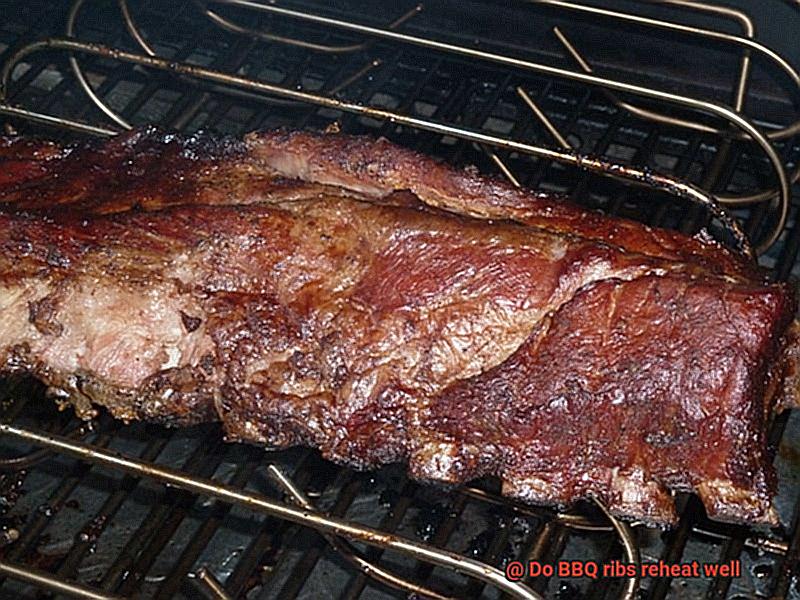
Tips for Reheating BBQ Ribs
Barbecue ribs are a delicious and flavorful dish that can be enjoyed hot off the grill. But what do you do when you have leftovers? Reheating BBQ ribs may seem like a daunting task, but with the right tips and techniques, you can ensure that your reheated ribs are just as delicious as the first time around.
Choose the right method
When it comes to reheating BBQ ribs, there are several methods to choose from. You can use an oven, a grill, a microwave, or even a sous vide cooker. The method you choose will depend on your personal preference and the equipment you have available. Each method has its advantages and disadvantages, so it’s important to choose the one that suits your needs.
Preheat the oven or grill
Before reheating your BBQ ribs, it’s crucial to preheat your oven or grill. This will ensure even cooking and help maintain the tenderness and juiciness of the ribs. For an oven, preheat it to around 325°F (163°C). For a grill, preheat it to medium heat.
Wrap the ribs
To prevent your reheated ribs from drying out, it’s recommended to wrap them tightly in aluminum foil or butcher paper. This will help retain moisture and prevent the meat from becoming tough.
Use a sauce or marinade
Adding a sauce or marinade can enhance the flavor of your reheated BBQ ribs. Brushing some barbecue sauce or marinade onto the ribs before reheating can help keep them moist and flavorful.
Monitor the temperature
It’s important to monitor the temperature of your reheating process to avoid overcooking or drying out the ribs. Use a meat thermometer to ensure that the internal temperature of the ribs reaches at least 165°F (74°C) for safe consumption.
Adjust cooking time
The cooking time for reheating BBQ ribs may vary depending on the method used and the thickness of the meat. It’s important to adjust the cooking time accordingly and check for doneness regularly to avoid overcooking. Remember, you just want to heat them through, not cook them again.
Rest before serving
Just like freshly cooked ribs, reheated BBQ ribs benefit from a short resting period before serving. Allowing the ribs to rest for a few minutes after reheating helps redistribute the juices, resulting in more tender and flavorful meat.
Enhancing the Flavor of Reheated BBQ Ribs
To truly enhance the flavor of reheated BBQ ribs, it is crucial to consider the method of reheating. While there are various options available, such as the oven, microwave, or grill, each method can yield different results in terms of flavor. The oven, for instance, is a popular choice as it allows for slow and gentle heat, preventing the ribs from drying out while allowing the flavors to meld together.
Once you have selected your preferred reheating method, there are several techniques you can employ to further enhance the flavor of the ribs. One exceptional technique involves marinating the ribs before reheating. To do this, simply brush the ribs with a marinade or barbecue sauce of your choice and let them sit for a few hours or overnight in the refrigerator. This process allows the flavors to penetrate the meat more deeply and adds an extra layer of taste when the ribs are reheated.
Another remarkable way to elevate the flavor of reheated BBQ ribs is by adding a finishing glaze or sauce. After fully reheating the ribs, whether on the grill or in the oven, you can brush them with a sweet or tangy glaze or sauce. This step not only introduces an additional layer of flavor but also creates a delectable caramelized crust on the outside of the ribs.
In addition to these techniques, serving the reheated BBQ ribs with complementary side dishes can further enhance their flavor. Classic barbecue sides like coleslaw, baked beans, cornbread, or macaroni and cheese provide a delightful contrast to the rich and smoky flavors of the ribs. These side dishes not only add variety to the meal but also help balance out the flavors and textures, resulting in a more enjoyable dining experience.
Storing Leftover BBQ Ribs
Storing leftover BBQ ribs is essential to ensure that their delicious flavor and tender texture are preserved for future enjoyment. By following a few simple steps, you can store and reheat your ribs to perfection.
Firstly, before storing the ribs, it is important to remove any leftover sauce or marinade. This prevents the sauce from being absorbed into the meat, which could affect its texture. Once the ribs are sauce-free, wrap them tightly in aluminum foil or place them in an airtight container. This creates a barrier that keeps air and moisture out, preserving the taste and tenderness of the meat.
To keep track of how long the ribs have been stored, remember to label the container with the date of storage. This way, you can ensure that the ribs are consumed within a safe time frame of 3-4 days when stored in the refrigerator.
When it comes to reheating your leftover BBQ ribs, it is best to avoid using the microwave, as it can dry out the meat. Instead, preheat your oven or grill to a low temperature around 250-300°F (121-149°C). Place the ribs on a baking sheet or grill grate and cover them with foil to prevent drying out during reheating.
Reheat the ribs for approximately 20-30 minutes or until they are heated through. This gentle reheating process ensures that the meat remains juicy and tender. For an extra burst of flavor and moisture, brush some barbecue sauce or broth onto the ribs before reheating.
After reheating, allow the ribs to rest for a few minutes before serving. This allows the flavors to settle and ensures optimal tenderness. Serve your reheated BBQ ribs alongside classic sides like coleslaw, baked beans, cornbread, or macaroni and cheese for a complete and satisfying meal.
If you want to store your BBQ ribs for longer periods, freezing is an option. Simply wrap them tightly in plastic wrap and place them in a freezer bag or airtight container. Frozen ribs can be stored for up to 3 months. When ready to enjoy, thaw the ribs overnight in the refrigerator before reheating using the same steps mentioned above.
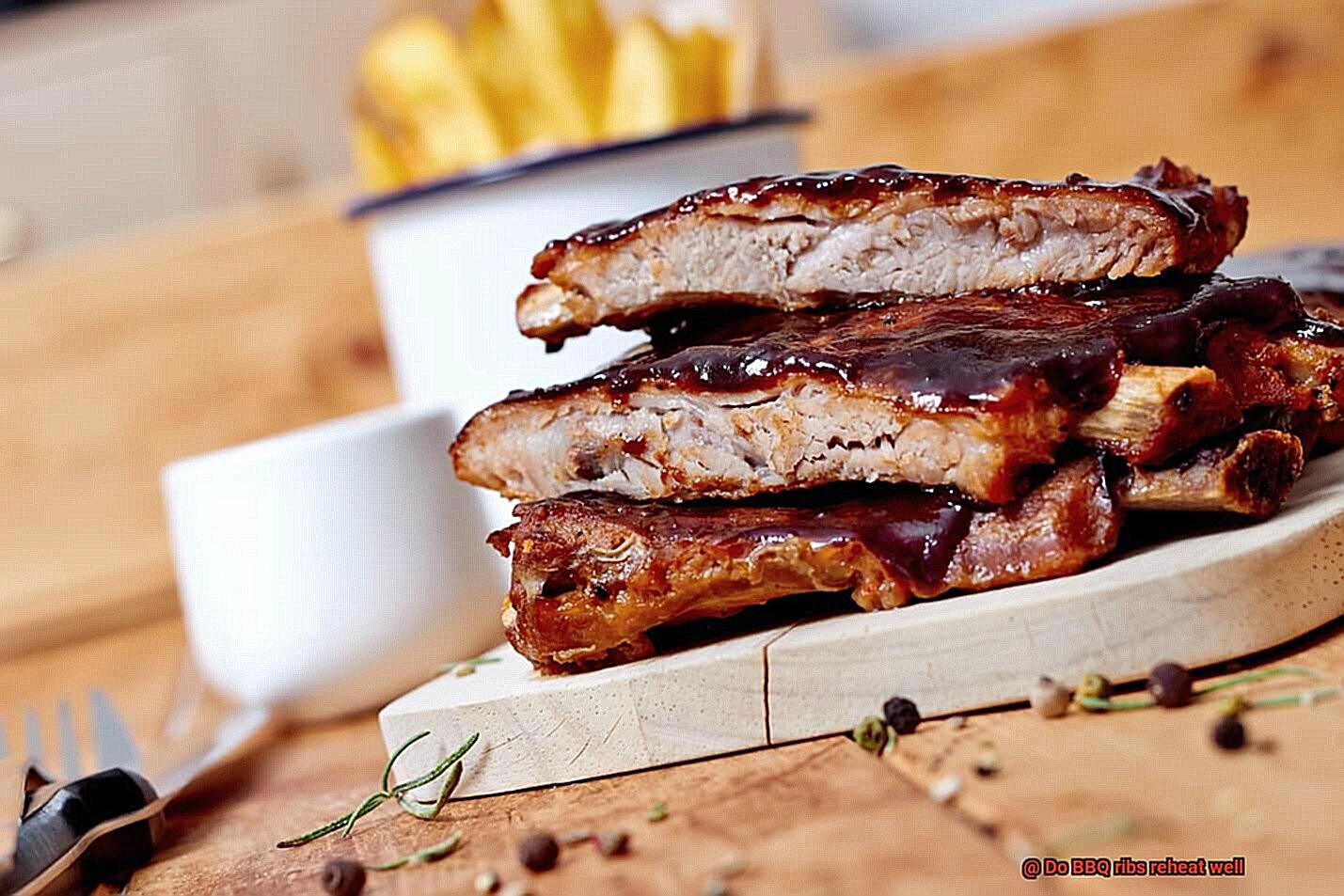
Texture and Taste of Reheated BBQ Ribs
Reheating BBQ ribs can be a delicate process, as it greatly impacts the texture and taste of the meat. When reheated, the ribs may become slightly drier compared to when they are freshly cooked. The heat from reheating causes some of the moisture in the meat to evaporate, resulting in a less juicy texture. However, with proper reheating techniques, the meat can still maintain a tender and succulent texture. It’s crucial to avoid overcooking the ribs during reheating, as this can make them dry and tough.
The taste of reheated BBQ ribs is also affected by the reheating process. If reheated using a method that retains moisture, such as in an oven or covered on a grill, the flavor remains relatively intact. However, if exposed to direct heat or open flames, like on a stovetop or uncovered on a grill, there is a risk of charring or burning the meat, which negatively impacts the taste. To avoid this, it’s important to monitor the ribs closely during reheating.
For the best texture and taste when reheating BBQ ribs, use a gentle heat source and avoid overcooking. Methods like wrapping the ribs in foil or using a low-temperature setting on an oven or grill help retain moisture and prevent excessive dryness. Applying a thin layer of sauce or marinade before reheating can enhance and maintain the flavor of the ribs.
Is It Worth Reheating BBQ Ribs?
Reheating BBQ ribs can have its pros and cons, and it ultimately depends on personal preference and the quality of the original cooking. But if you’re thinking about reheating your BBQ ribs, here are some considerations to keep in mind:
Pros:
- Convenience: Reheating BBQ ribs allows you to enjoy leftovers without having to cook an entire meal from scratch.
- Cost-effective: If you’ve invested time and money into preparing a delicious rack of ribs, reheating them can prevent waste and save you money.
- Flavor development: Some individuals argue that reheating can actually enhance the flavors of the ribs, as the spices and seasonings have more time to meld together.
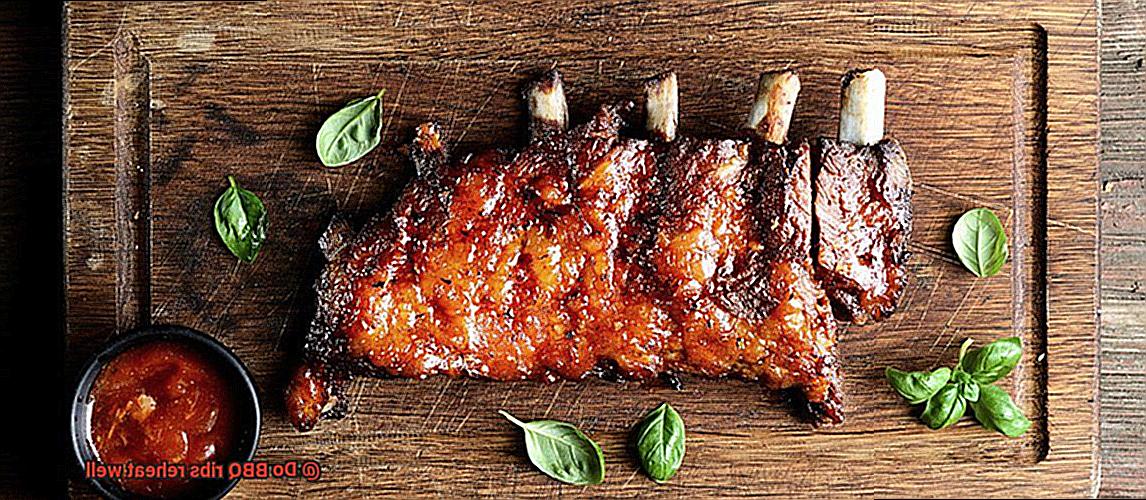
Cons:
Loss of moisture: Heat can cause the moisture in the ribs to evaporate, resulting in dry meat.
Sauce deterioration: Some sauces may lose their intensity or become overly sweet when reheated.
To make reheating BBQ ribs worth it, consider the following tips:
- Cooking method: Use low and slow cooking methods, such as smoking or slow roasting, to retain moisture and flavor in the ribs.
- Storage: Properly store cooked ribs in an airtight container or wrap them tightly in foil to prevent them from drying out before reheating.
- Gentle reheating: Use a low oven temperature or grill to gently reheat the ribs, as high heat can further dry out the meat.
- Fresh glaze or sauce: Add a fresh glaze or sauce just before serving to revive any diminished flavors during reheating.
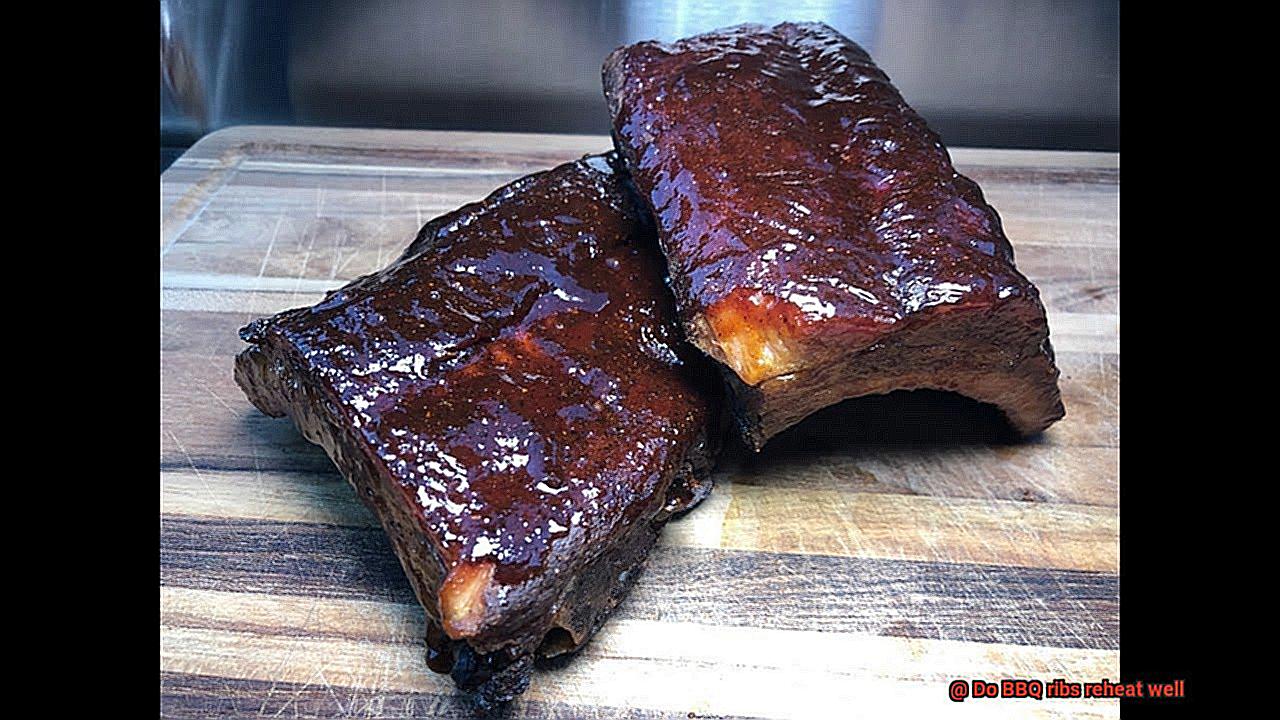
wfk8p7HKGno” >
Conclusion
In conclusion, BBQ ribs can indeed be reheated to delicious perfection.
The key lies in the proper technique and a little bit of patience. By using low and slow heat, you can preserve the tenderness and juiciness of the meat.
Whether you choose to reheat them in the oven, on the grill, or even in a smoker, the result will be mouthwatering ribs that are just as good as when they were first cooked.

